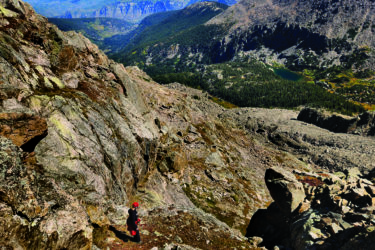The Local newsletter is your free, daily guide to life in Colorado. For locals, by locals.
My first memory is of crashing. Making my way down a slender, treed ski run, three-year-old me picked up too much speed and face-planted into the snow. I don’t remember the pain that must have seared through my jaw or how I got to the bottom of the mountain. I do recall clunking down the stairs—cracked goggles in hand—and into Eskimo Ski Club’s headquarters at Winter Park Resort, where I was greeted by a raucous round of applause. I can still feel the pride that swelled in my chest.
Founded by ski industry pioneer Frank Bulkley in 1939, the club known colloquially as Eskimo’s was among the first ski schools in Colorado (and one of the last independent ones). Over the next eight decades, the club would teach thousands of Denver kids how to navigate the slopes, and there was never any question I would be among them. My grandparents, Tom and Katie Branch, were Eskimo’s directors. They took over in 1959, the same year they got married—and they adored the school so much their vows included promises “to love, honor, and teach at Eskimo’s for as long as we both should live.” At 84 and 88, my grandparents are still alive and skiing. Sadly, Eskimo’s isn’t.
This past August, Eskimo’s announced it would close just shy of its 80th birthday, which would have been this month. Winter Park Resort needed the club’s longtime headquarters for more employee locker space. Eskimo’s could have relocated, but Bulkley’s daughter, then the owner, feared that might raise the cost of lessons. (Last season, an Eskimo’s membership ran $325 to $520 for 10 weeks of lessons, while Winter Park Ski & Ride School charged $179 a day or $459 to $499 for four weeks’ worth.) My grandparents, who worked as Eskimo’s instructors until it shut down, are heartbroken. I’m heartbroken, too—for them, but also because Eskimo’s closing represents another lost chapter in Colorado ski history.
Frank Bulkley’s mission was to get city kids to the slopes, and he did that by talking the Denver and Salt Lake Railroad into launching the Ski Train from Union Station to Winter Park. Every Saturday from January to March, as many as 1,600 children hopped on the train—without their parents—before dawn and returned late that night.
Once on the mountain, a color system denoted expertise. Students had to pass tests to move up from rookie green all the way to expert black for skiers and expert purple for snowboarders. (If my grandma deemed my brother or me good enough, she sometimes passed along the next ribbon without officially grading our abilities. We’d sew them onto the arms of our ski jackets like medals.) Although instructors were taskmasters in the morning, during the afternoon students older than 10 and above a certain skill level were allowed to roam the slopes in pairs. Sure, we lost a ski or two attempting too-tough mogul runs. We also learned a lot about responsibility and independence. In 79 years, no kid was left behind.
I feel the loss of Eskimo’s most acutely when I think of the club’s basement headquarters being transformed into locker space. When I grew cold, I was allowed to stay there, alone among dozens of old skis. I wondered where the skis had been, sometimes penning their memoirs on a legal pad. Those hours of solitude started me on a trajectory toward my career as a journalist.
Now the space will likely become uniform, lacking material that might spark the imagination of a nine-year-old. No child will ever stomp down its steps, fuming with pain and embarrassment, only to be redeemed by the discovery that she’s gained initiation into a special club that will shape her life for years to come. She’ll never be praised for falling.









